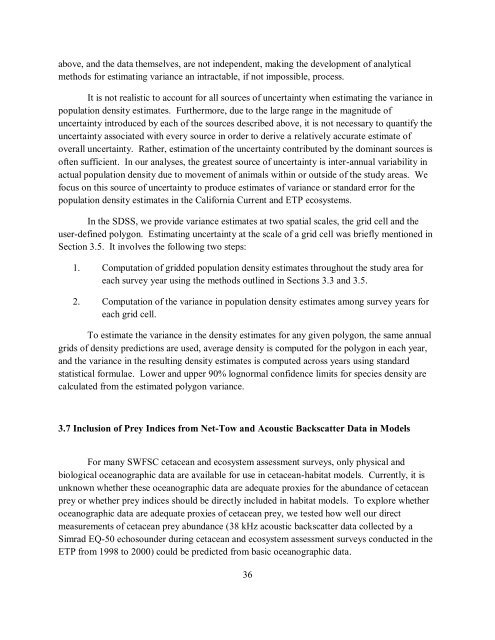Final Technical Report: - Southwest Fisheries Science Center - NOAA
Final Technical Report: - Southwest Fisheries Science Center - NOAA
Final Technical Report: - Southwest Fisheries Science Center - NOAA
Create successful ePaper yourself
Turn your PDF publications into a flip-book with our unique Google optimized e-Paper software.
above, and the data themselves, are not independent, making the development of analytical<br />
methods for estimating variance an intractable, if not impossible, process.<br />
It is not realistic to account for all sources of uncertainty when estimating the variance in<br />
population density estimates. Furthermore, due to the large range in the magnitude of<br />
uncertainty introduced by each of the sources described above, it is not necessary to quantify the<br />
uncertainty associated with every source in order to derive a relatively accurate estimate of<br />
overall uncertainty. Rather, estimation of the uncertainty contributed by the dominant sources is<br />
often sufficient. In our analyses, the greatest source of uncertainty is inter-annual variability in<br />
actual population density due to movement of animals within or outside of the study areas. We<br />
focus on this source of uncertainty to produce estimates of variance or standard error for the<br />
population density estimates in the California Current and ETP ecosystems.<br />
In the SDSS, we provide variance estimates at two spatial scales, the grid cell and the<br />
user-defined polygon. Estimating uncertainty at the scale of a grid cell was briefly mentioned in<br />
Section 3.5. It involves the following two steps:<br />
1. Computation of gridded population density estimates throughout the study area for<br />
each survey year using the methods outlined in Sections 3.3 and 3.5.<br />
2. Computation of the variance in population density estimates among survey years for<br />
each grid cell.<br />
To estimate the variance in the density estimates for any given polygon, the same annual<br />
grids of density predictions are used, average density is computed for the polygon in each year,<br />
and the variance in the resulting density estimates is computed across years using standard<br />
statistical formulae. Lower and upper 90% lognormal confidence limits for species density are<br />
calculated from the estimated polygon variance.<br />
3.7 Inclusion of Prey Indices from Net-Tow and Acoustic Backscatter Data in Models<br />
For many SWFSC cetacean and ecosystem assessment surveys, only physical and<br />
biological oceanographic data are available for use in cetacean-habitat models. Currently, it is<br />
unknown whether these oceanographic data are adequate proxies for the abundance of cetacean<br />
prey or whether prey indices should be directly included in habitat models. To explore whether<br />
oceanographic data are adequate proxies of cetacean prey, we tested how well our direct<br />
measurements of cetacean prey abundance (38 kHz acoustic backscatter data collected by a<br />
Simrad EQ-50 echosounder during cetacean and ecosystem assessment surveys conducted in the<br />
ETP from 1998 to 2000) could be predicted from basic oceanographic data.<br />
36









